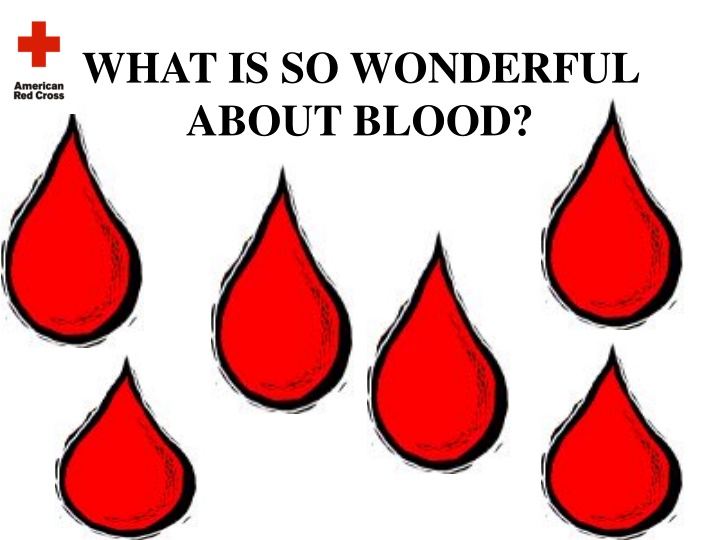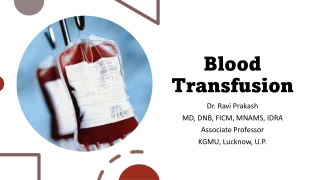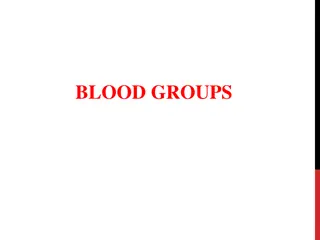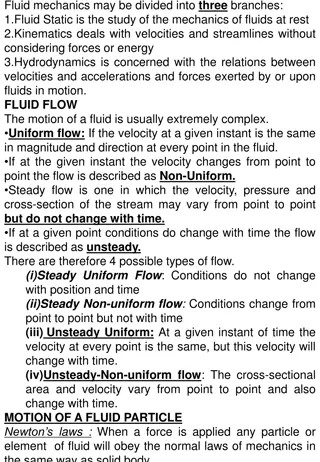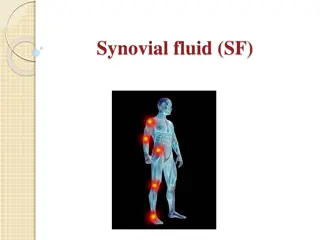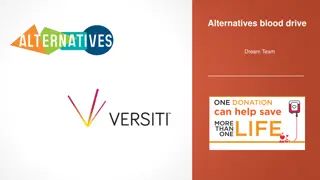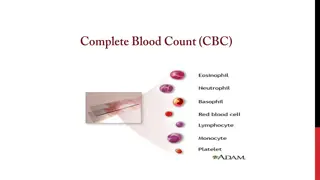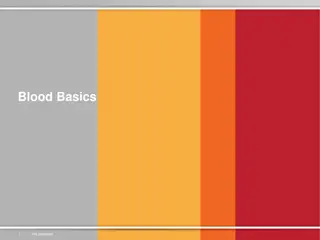Wonderful World of Blood: A Vital Fluid's Role in Human Life
Blood, a vital component of human life, flows throughout the body, supplying oxygen, nutrients, and proteins to our cells. Red blood cells carry oxygen, plasma provides essential proteins, and platelets aid in clotting to prevent excessive bleeding. The need for blood transfusions in emergencies underscores its life-saving importance. Blood donation can be divided into red cells, plasma, and platelets, enabling targeted treatment for patients in need. With interesting facts and figures, the significance of blood in medical procedures becomes evident.
Download Presentation

Please find below an Image/Link to download the presentation.
The content on the website is provided AS IS for your information and personal use only. It may not be sold, licensed, or shared on other websites without obtaining consent from the author.If you encounter any issues during the download, it is possible that the publisher has removed the file from their server.
You are allowed to download the files provided on this website for personal or commercial use, subject to the condition that they are used lawfully. All files are the property of their respective owners.
The content on the website is provided AS IS for your information and personal use only. It may not be sold, licensed, or shared on other websites without obtaining consent from the author.
E N D
Presentation Transcript
WHAT IS SO WONDERFUL ABOUT BLOOD?
BLOOD Blood flows everywhere through the human body. We cannot live without it. The heart pumps blood to all our body cells, supplying them with oxygen and food. Blood also carries proteins and cell fragments called platelets that let blood clot where there has been an injury.
RED BLOOD CELLS Red blood cells carry oxygen to body tissues and remove carbon dioxide. They are red because they contain a protein called hemoglobin that is red in color. Red blood cells are round and thinner in the middle, like a balloon that is partly filled with water. This lets them squeeze through tiny blood vessels without breaking.
PLATELETS If a blood vessel is cut, platelets stick to the edges of the cut and to one another, forming a plug that stops bleeding. They then release chemicals that react with fibrinogen and other clotting proteins, leading to the formation of a blood clot. The blood vessel can then heal over the cut area.
PLASMA Plasma is the liquid part of your blood in which red cells and platelets float. Plasma is mostly water, but the proteins it contains are necessary for life. Some of of these proteins are clotting proteins.
BLOOD FACT If someone is in an accident, has surgery or gets cancer, they may need another person s blood to help them survive. There is no substitute for blood transfusion. This blood comes from blood donors.
BLOOD FACT In the United States, a blood transfusion is needed about every two seconds.
What time is it?
DID YOU KNOW? When someone donates a pint of blood, that blood is separated into red cells, plasma and platelets. Each one of these can be given to a different patient who needs only that part of the blood.
BLOOD FACT A kidney transplant patient, on average, will need one to two units of red blood cells to get through surgery. A heart transplant patient, on average, will need four to six units of red blood cells.
PLASMA Plasma transfusion helps hundreds of patients with liver disease, severe burns, hemophilia, and leukemia. Transplant and cardiac patients are also helped by plasma transfusions. Plasma provides essential clotting factors to these patients.
BLOOD FACT A liver transplant patient, on average, will need six to 10 units of red blood cells, 20 units of plasma and 10 units of platelets.
BLOOD FACT A newborn open-heart surgery, on average, will need one to four units of red blood cells, one to two units of plasma, and one to four units of platelets.
BLOOD TYPE Not everyone has the same blood type! Blood type refers to features of the person s red blood cells. There are hundreds of these different features.
BLOOD TYPE The ABO blood groups are the features most people know about. In this group, there are 4 different types of red blood cells -- A, B, AB, and O.
BLOOD TYPE About half of us are blood group O The next most common is blood group A. Few people have type B, and even fewer have type AB.
BLOOD TYPE Th Rh blood groups are the next most familiar types. People whose red cells have a particular feature called the D antigen are Rh positive. People who lack the factor are Rh negative. Most people are Rh positive.
BLOOD TYPE Type O blood may be transfused into patients of any blood type. Rh negative blood may be transfused into patients of either Rh type. So O negative is a very special blood type in a blood donor.
BLOOD FACT About half of Americans can safely be blood donors. But only about 5 percent actually donate blood. The other 95% are relying on these donors if they ever need a transfusion.
DONATING BLOOD IS EASY http://www.redcross.org/flash/giftoflife/giftoflife.html It is quick and it is safe. It doesn t hurt badly at all. And it saves lives.
WOULD YOU LIKE TO TAKE A QUIZ? https://corpweb.redcross.org/biomed/refcent/flash/start.html
TODAY WE WOULD LIKE TO ASK YOU TO: Seriously consider becoming a blood donor when you become 17 years old. If you know somebody who has been helped by a blood transfusion, think about the good person that made a blood donation to help your friend.
Think about organizing a blood drive at your school or help at a blood drive in your community. Talk with an adult about the importance of donating blood. Together, we can save a life. It is one of the most important things you can do.
WHAT TIME IS IT? So how much time has passed since we started? Many, many people have needed blood. Remember, the only way for someone to receive blood is for another person to donate it.
FIRST AID CPR WATERSAFETY DISASTER RELIEF INTERNATIONAL SERVICES ARMED FORCES EMERGENCES SERVICES YOUTH
Call 1-800-GIVE LIFE to make your appointment to donate today
This powerpoint was kindly donated to www.worldofteaching.com http://www.worldofteaching.com is home to over a thousand powerpoints submitted by teachers. This is a completely free site and requires no registration. Please visit and I hope it will help in your teaching.
